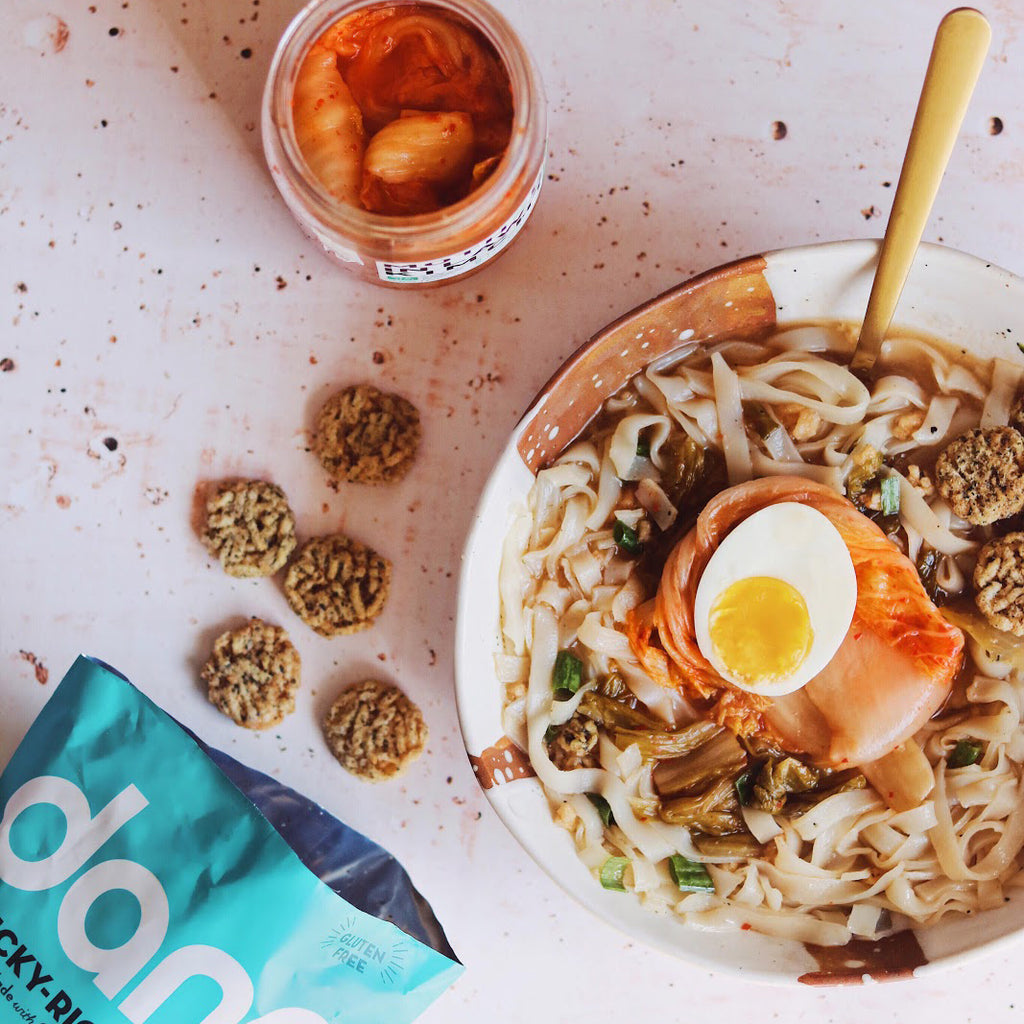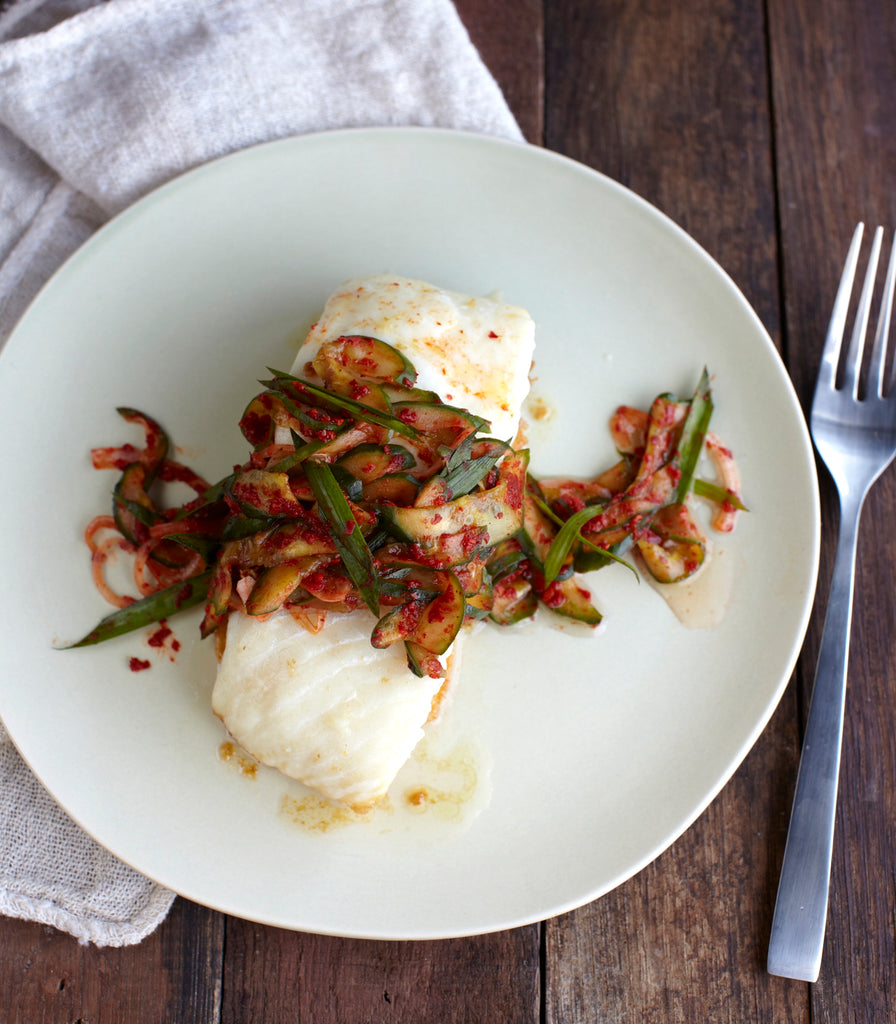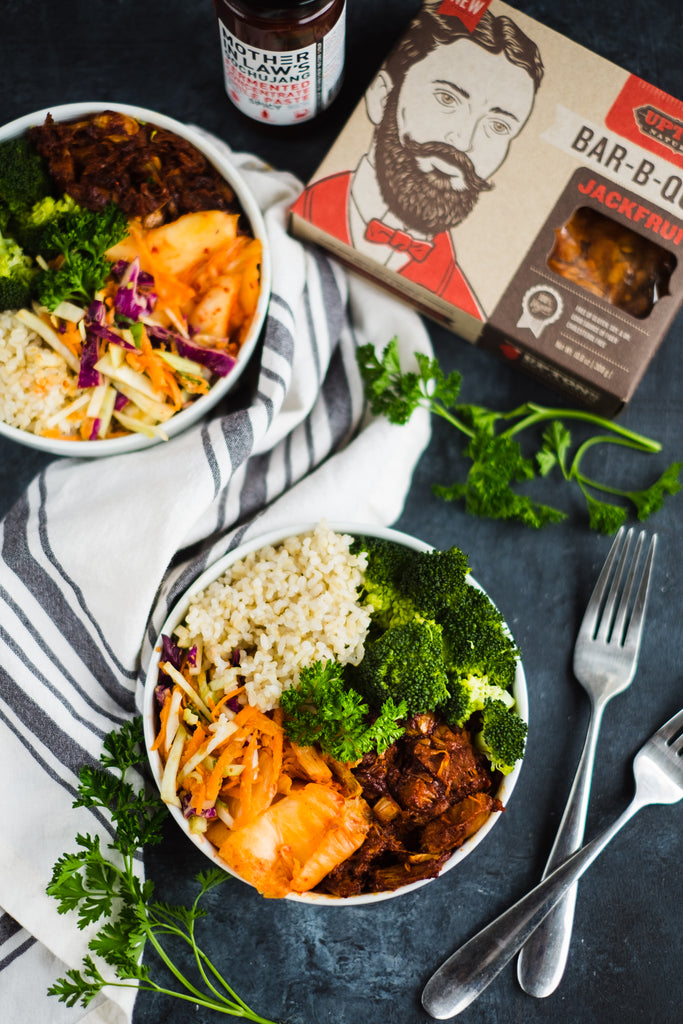What do Sticky-Rice Chips, kimchi, and noodle soups have in common? Tradition, flavor, and culture.
(Pssst! Find a super yummy miso soup recipe that combines all of these ingredients at the bottom of this post!)
At Mother-in-Law's Kimchi, we're passionate about connecting cultures for a healthier and more flavorful world, which is why we teamed up with Dang Foods and Nona Lim to talk food, identity, and culture.
Meet the founders - Lauryn Chun, Vincent Kitirattragarn, and Nona Lim - and learn how they built their Asian-American brands.
LAURYN CHUN, MOTHER-IN-LAW'S KIMCHI FOUNDER
What was it like growing up with an identity that sits between two cultures?
I think it was like walking along a bridge between two places, one traditional - Korean and one mainstream - American. I remember tasting pizza and tomatoes for the first time and worrying about how American foods come with side dishes that were foreign to me, unlike banchan and kimchi that were familiar at every meal at home. It was juggling between school and home and a balancing act of two cultures and navigating my way. Like many kids, I felt like an outsider immigrating to the U.S. at the age of 7 years old and trying to fit in, there was a lot of embarrassment about the food and differences rather than ‘celebration’ that is happening now which is so great. I love that I can see how much our American/global culture towards food has changed because of so many things but perhaps because of mutual connection to each other through the internet, the world is a much smaller place.

Which food brings you back to your childhood? Tell us about it. How did it taste and smell? As an adult, what feeling does it evoke for you?
Making kimchi in my commercial kitchen when launching MILK, brought me back to my earliest childhood memories of food at age six, making ‘kimjang’ (kimchi block party) kimchi with my grandmother. Kimjang is 2-3 day annual event of kimchi-making in late fall to gather last of fall’s harvest of napa cabbage. Each family and their neighbors gather together to make a communal batch of kimchi, enough to last through all winter before spring’s bounty of vegetables.
What is the biggest inspiration for your brand?
The most important and interesting part of what we do is people’s discovery of fermented foods as a flavor and its health benefits. Kimchi is a raw, living food with probiotics for a healthy gut and Gochujang has deep layered flavors that come from fermentation and are beneficial for health, more than the processed condiments in our food system. I love that kimchi is not just an accompaniment with Korean food but a probiotic flavorful boost to anything you eat. Same with Gochujang - as an all-purpose secret sauce that adds deep spicy flavor to just about anything.
What do you like most about the foods you've created?
I like how fermented flavors are a natural process with ancient, traditional ways to preserve and make flavorful healthy foods. Kimchi and Gochujang come from 500+ years of tradition of fermenting and preserving before the modern age of refrigeration.

How do you feel about the heightened representation of Asian Americans in American pop culture? What's your hope for the future?
Very exciting time for Asian and International ethnic Foods... As a kid, I would never have imagined that Kimchi and Gochujang would be mainstream but I like to think that MIL as a brand has contributed to the conversation, linking similarity of all western and eastern fermented foods (soy sauce, miso, cheese) are something everyone loves! They have more in common than separateness, much like people.
VINCENT KITIRATTRAGARN, DANG FOODS FOUNDER
What was it like growing up with an identity that sits between two cultures?
Every Asian-American has asked themselves "who am I?" without an easy answer. Imagine you're a turtle, and you're in a pond full of fish. You're still a part of the pond, but you know you're different than the others. Sometimes it feels like there's a vibrant community of different beings in the pond and you're just living your life. Other times it feels like you're the only one of your kind, and your differences keep you separate from the others like a fish out of water.
For me, I grew up hyper-aware of my Asian heritage, and hyper-aware of Americans' knowledge of my heritage. For Halloween every year I was Karate Kid because that was culturally accessible to non-Asians in the late 1980s. The irony of dressing up a white guy who does Asian martial arts isn't lost on me - more on that later. At the time, it felt like the only way to own my race in a way accessible to Americans.
At this point, I didn't fully embrace the Asian part of my identity - in 3rd grade I would sometimes dress up as a cowboy to go to school. I have to think Marlboro's marketing and Burt Reynolds-esque images of masculinity were complicit in pushing me toward Western styles. My lunchbox, however, would remain pretty Asian with soy sauce chicken and rice.
Later on, I found food to be a way to embrace my identity in a relatable way. People would say "I love Thai food" when finding out about my heritage and wax poetic about their favorite dish. It was an easy way to feel connected to others so I leaned into it and ended up doing a Thai pop-up restaurant in SF that led to Dang.
In a world where labels polarize and ostracize, it's nice to dream of a time when labels don't exist so that people can have the space to breathe and just be themselves. Until then, taking ownership and pride in your heritage is a source of strength and inspiration. Places, smells, designs, even people feel right because they're familiar in an intimate way. Ultimately I see my heritage as the color that makes my life brighter, more vibrant, and much much tastier.

Which food brings you back to your childhood? Tell us about it. How did it taste and smell? As an adult, what feeling does it evoke for you?
For me, Gai Yang (Northern Thai Grilled Chicken) with Khao Niew (Sticky-Rice) brings me back to childhood. Chickens are indigenous to Southeast Asia and if you ever visit, you'll notice how lean they are versus American factory-farmed birds. They tend to run around even more than the free-est range chickens do in the US, and eat everything from bugs to food scraps turning the egg yolks a super healthy orange. Gai Yang is made by marinating a young chicken in dozens of herbs and aromatics, spatchcocking it, and grilling it on charcoal. It's served with a sweet chili dipping sauce (that McDonald's stole for their nuggets).
The best way to eat it is: put a chunk of thigh meat on top of a wad of sticky-rice and pretend it's nigiri. Dip it and eat the whole thing. So dang good!
What is the biggest inspiration for your brand?
We look to our Thai-Chinese culture for inspiration. The ingredients and flavors of Southeast and East Asia are what make our snacks. We've always leaned into Asian ingredients like coconut, rice and nuts, and believe that eating low-carb, plant-based diets make people healthier and more energetic. We couple this approach with modern nutrition principles to create snacks that actually taste good and are good for you.

What do you like most about the foods you've created?
They represent an array of textures, flavors, and ingredients not seen elsewhere in the market. As children of immigrants, we eat differently and we bring that with us into our food.
Of all the elements of culture: food, language, dress, music, dance, literature, art, and style, food stays around the longest when people immigrate. The fact that it's meant to be eaten communally, with family makes it tough to shake over multiple generations.
How do you feel about the heightened representation of Asian Americans in American pop culture? What's your hope for the future?
This is important to me, because as I alluded to earlier, there weren't a lot of Asian Americans in the media when I was a kid. When you're forming your identity you look to role models - I had my parents but other than that it was Jackie Chan and Jet Li, that's about it. I remember seeing Better Luck Tomorrow in the late 90s and being amazed at seeing good looking, confident, masculine actors like John Cho on the big screen. They didn't have to prove themselves with martial arts - they could just be themselves. I knew I wanted more but Hollywood didn't agree until recently. I think you saw the upswells of Asian media interest with popular Youtubers like Wong Fu Productions and Ryan Higa. They were making content for Asian Americans by Asian Americans in a time when there wasn't any in TV and Movies, and people ate it up.
How do I feel about heightened representation? SO FREAKING PROUD! And not just for Asian Americans - all types of stories are being told that weren't before. I think you're seeing a grassroots change in what people want to see and feel - authentic, real stories with complex characters, and that's being reflected on the big screen. When the lack of visibility and awareness of your race is integral to your development, seeing yourself on screen feels the same as being seen in real life.
My hope for the future is that these stories continue to be told, so the next generation of Asian Americans can create a healthy self-image with a ton of role models to choose from.
NONA LIM, NONA LIM FOUNDER
What was it like growing up with an identity that sits between two cultures?
I actually grew up in Singapore and it was a melting pot of lots of different cultures like Chinese, Malay, and Indian to name a few. The fabric of Singapore is really multi-cultural – in terms of food, holidays, languages, and religions. I believe it made me curious, inquisitive, and also tolerant.

Which food brings you back to your childhood? Tell us about it. How did it taste and smell? As an adult, what feelings does it evoke for you?
Noodles and broths – Singapore has so many different kinds of noodles and so many different styles! As a child, I would go to Hawker Centers and there would be noodles cooked at least 20 different ways. It really inspired me to make authentic noodles and I often eat them at home as a quick stir-fry or with a broth-based soup.
What is the biggest inspiration for your brand?
As a former athlete, I was constantly seeking natural ways to gain a competitive advantage. I observed how my body would only function at peak performance when fueled with whole, clean foods. So I became a Certified Nutrition Consultant to learn more holistically about food as medicine. In 2014, the Nona Lim brand was born - to bring my favorite dishes from my childhood in Singapore, but made with the wonderful ingredients available in the Bay Area.
What do you like most about the foods you've created?
We focus on clean-label fresh Asian products like slow-simmered bone broths and soups with healing Asian herbs, and fresh rice noodles and ramen; these are all dishes that nourish me and remind me of the comfort of home. I wanted to create products that not only have amazing flavors that are great for you, but also EASY to enjoy.

MISO SOUP WITH DANG SEAWEED STICKY-RICE CHIPS, MOTHER-IN-LAW'S KIMCHI, AND NONA LIM MISO RAMEN BROTH

Ingredients:
1 pouch of Miso Ramen Broth and 1 box of Traditional Ramen from Nona Lim’s Miso Ramen Night Kit
Mother in Law’s House Kimchi
Dang’s Seaweed Sticky Rice Chips
1 soft-boiled egg
Green onions to taste
Recipe:
1. Open Nona Lim Miso Ramen Broth pouch and pour into pot. Simmer on stove until hot.
2. In a separate pot, bring water to a boil and cook Nona Lim Traditional Ramen noodles for 1 to 2 minutes.
3. Place the ramen into a soup bowl, pour hot broth into bowl and garnish with a handful of green onions.
4. Optional: Add a soft boiled egg
5. Top with a heaping scoop of Mother in Law’s Kimchi, then crumble Dang Sticky Rice Seaweed Chips for a savory taste.
Enjoy!




